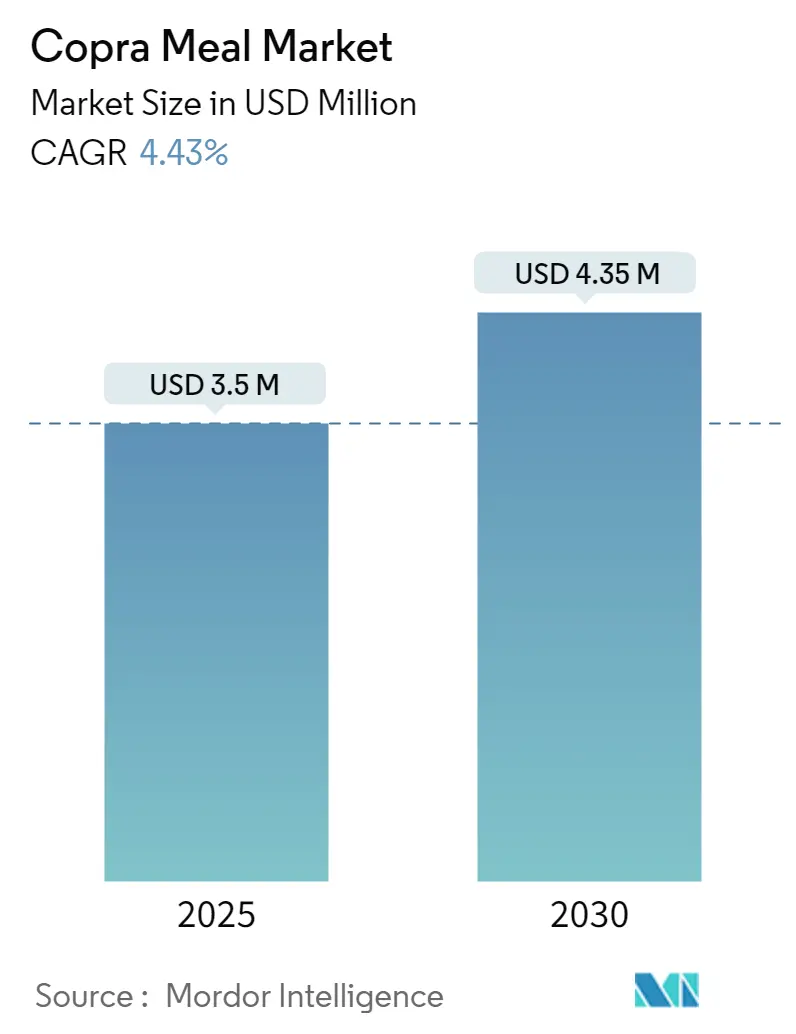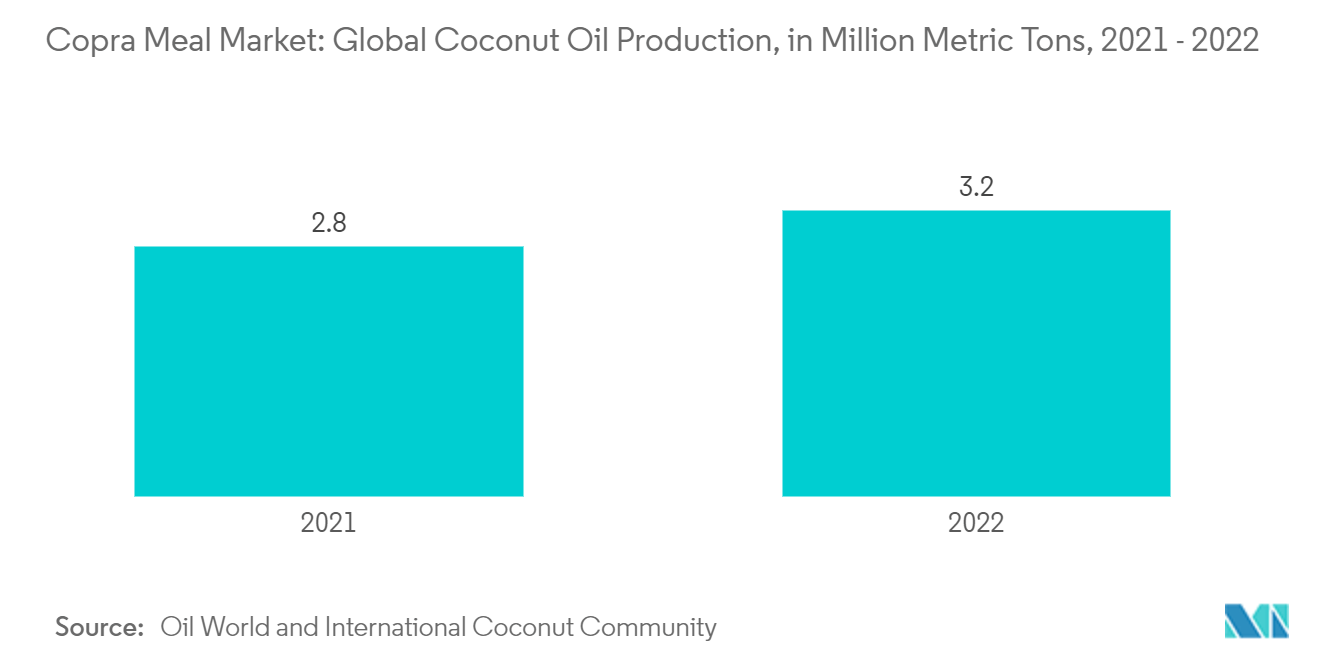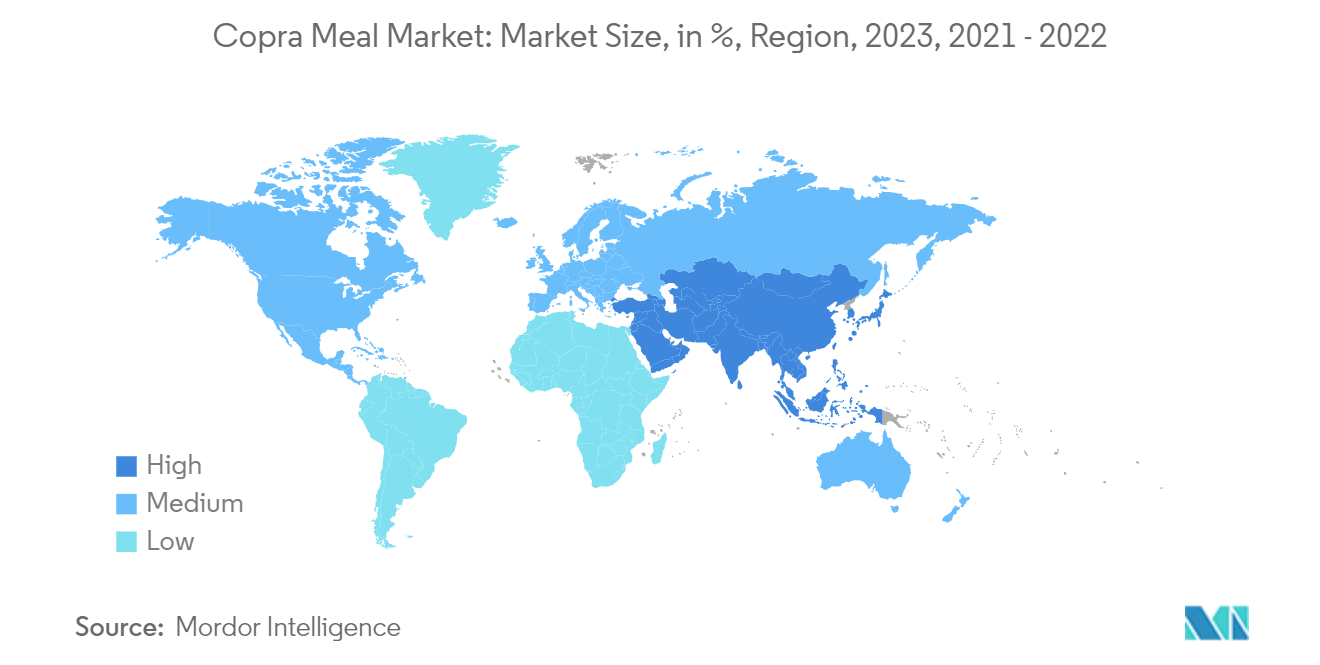Copra Meal Market Size and Share

Copra Meal Market Analysis by Mordor Intelligence
The Copra Meal Market size is estimated at USD 3.50 million in 2025, and is expected to reach USD 4.35 million by 2030, at a CAGR of 4.43% during the forecast period (2025-2030).
- Copra meal, rich in protein and fiber, is a preferred ingredient in livestock feed, particularly for dairy and poultry industries. The global increase in livestock production supports the demand for feed ingredients like copra meal. The Food and Agriculture Organization of the United Nations (2023) reported that the world's cattle population reached 10.96 billion in 2022, a 1.4% increase from the previous year's 10.81 billion.
- Asia-Pacific is the largest region in the global copra meal market, primarily due to its high coconut palm production. Copra, a by-product of coconut oil extraction, is predominantly grown in coastal areas. According to FAOSTAT, in 2022, Asia-Pacific countries, including Indonesia, the Philippines, and India, collectively accounted for 73% of global coconut production.
- Globally, there is an increasing demand for animal-sourced products such as meat, eggs, and milk compared to plant-originated foods like cereals. This demand for animal products requires alternative meals such as copra meal to boost production, stimulating the growth of copra meal in the animal feed market. The USDA Livestock and Poultry: World Markets and Trade report indicates that global consumption of beef and veal is expected to reach 59.5 million metric tons in 2024, an increase from the previous year's volume of 58.3 million metric tons.
Global Copra Meal Market Trends and Insights
Rising Copra and Coconut Oil Production
- Coconut oil is extracted from copra, the dried flesh of coconuts. The extraction process yields two main byproducts: copra cake from mechanical extraction and copra meal from subsequent solvent extraction. In the Philippines, a major coconut producer, approximately 80% of coconuts are processed into copra for oil production. The country's copra production increased from 2.6 million metric tons in the previous year to 2.7 million metric tons in MY 2023-2024. This increase in production is supported by the country's infrastructure, which includes 62 copra mills with a total annual capacity of 3 million metric tons of crude and refined oil and 35,000 metric tons of virgin coconut oil for domestic and export markets, according to the USDA Oilseeds and Products Annual Report 2024.
- The availability of copra meal is directly correlated with coconut oil production. As the demand for coconut oil in cooking, cosmetics, and industrial applications increases, so does the supply of copra meal. This relationship is evident in recent global production figures. The Oil World and International Coconut Community reported that global coconut oil production in 2022 reached 3.2 million metric tons, a 16% increase from the previous year's 2.8 million metric tons. This significant growth in coconut oil production indicates a corresponding increase in copra meal availability, highlighting the interconnected nature of these products in the coconut processing industry.

Asia-Pacific Region Dominates the Market
- The feed industry in Asia-Pacific is experiencing rapid growth, driven by increasing meat consumption and export opportunities. In 2022, China's domestic chicken consumption reached 15 million metric tons, a 4.2% increase from the previous year's 14.4 million metric tons. This growth, coupled with the positive outlook for the coconut crop industry, presents significant opportunities for copra meal producers in the region.
- Southeast Asia, South Asia, and Pacific Island countries, major producers and consumers of coconuts, are driving market growth. Copra meal's high-quality protein content, which aids in animal meat production, has increased its usage in Asian countries with significant meat production. In 2022, Indonesia led coconut production with 17.19 million metric tons, according to FAOSTAT. The Philippines was the largest producer of coconut oil, with 1.3 million metric tons in 2022, a 31.8% increase from the previous year's 0.9 million metric tons.
- Governments in the region are promoting coconut products through various projects. The Philippine Coconut Authority (PCA) has implemented the Coconut Planting and Replanting Project 2023-2028, aiming to replant 100 million coconut trees by 2028. These initiatives are expected to contribute to the growth of the copra meal market in the forecast period.

Recent Industry Developments
- May 2023: The Philippine Department of Agriculture has announced plans to begin commercial production of protein-enriched copra meal (PECM) in the fourth quarter, aiming to reduce animal feed imports. Two production facilities, with a combined budget of P50 million (USD 850 thousand), are currently under construction in Batangas and North Cotabato. The department expects these facilities to be operational within the next two quarters.
- January 2023: The Papua New Guinea Minister for Agriculture, Aiya Tambua, announced a new price incentive for Copra. This price support measure aims to benefit coconut farmers throughout the country. Brown coconut will now be bought at a price of K2 (USD 0.5), which is an increase of K1.1 (USD 0.27), while white coconut will be bought at K2.50 (USD 0.62).
Global Copra Meal Market Report Scope
Copra meal is a 100% natural animal feed with a sweet aroma and coconut flavor. It contains 10-15% coconut oil or fat content, making it a high-value feed for livestock. The copra meal market is geographically segmented into North America, Europe, Asia-Pacific, South America, and Africa. The report provides a detailed analysis of production volume, consumption value and volume, import value and volume, and export value and volume, along with pricing information for each region. The report presents market estimations and forecasts in both value (USD) and volume (Metric Tons) for all the aforementioned segments.
| North America | United States | Production Analysis |
| Consumption Analysis | ||
| Import Market Analysis (Volume and Value) | ||
| Export Market Analysis (Volume and Value) | ||
| Price Trend Analysis | ||
| Canada | Production Analysis | |
| Consumption Analysis | ||
| Import Market Analysis (Volume and Value) | ||
| Export Market Analysis (Volume and Value) | ||
| Price Trend Analysis | ||
| Mexico | Production Analysis | |
| Consumption Analysis | ||
| Import Market Analysis (Volume and Value) | ||
| Export Market Analysis (Volume and Value) | ||
| Price Trend Analysis | ||
| Europe | Germany | Production Analysis |
| Consumption Analysis | ||
| Import Market Analysis (Volume and Value) | ||
| Export Market Analysis (Volume and Value) | ||
| Price Trend Analysis | ||
| United Kingdom | Production Analysis | |
| Consumption Analysis | ||
| Import Market Analysis (Volume and Value) | ||
| Export Market Analysis (Volume and Value) | ||
| Price Trend Analysis | ||
| France | Production Analysis | |
| Consumption Analysis | ||
| Import Market Analysis (Volume and Value) | ||
| Export Market Analysis (Volume and Value) | ||
| Price Trend Analysis | ||
| Spain | Production Analysis | |
| Consumption Analysis | ||
| Import Market Analysis (Volume and Value) | ||
| Export Market Analysis (Volume and Value) | ||
| Price Trend Analysis | ||
| Asia Pacific | China | Production Analysis |
| Consumption Analysis | ||
| Import Market Analysis (Volume and Value) | ||
| Export Market Analysis (Volume and Value) | ||
| Price Trend Analysis | ||
| Japan | Production Analysis | |
| Consumption Analysis | ||
| Import Market Analysis (Volume and Value) | ||
| Export Market Analysis (Volume and Value) | ||
| Price Trend Analysis | ||
| India | Production Analysis | |
| Consumption Analysis | ||
| Import Market Analysis (Volume and Value) | ||
| Export Market Analysis (Volume and Value) | ||
| Price Trend Analysis | ||
| Vietnam | Production Analysis | |
| Consumption Analysis | ||
| Import Market Analysis (Volume and Value) | ||
| Export Market Analysis (Volume and Value) | ||
| Price Trend Analysis | ||
| Australia | Production Analysis | |
| Consumption Analysis | ||
| Import Market Analysis (Volume and Value) | ||
| Export Market Analysis (Volume and Value) | ||
| Price Trend Analysis | ||
| South America | Brazil | Production Analysis |
| Consumption Analysis | ||
| Import Market Analysis (Volume and Value) | ||
| Export Market Analysis (Volume and Value) | ||
| Price Trend Analysis | ||
| Argentina | Production Analysis | |
| Consumption Analysis | ||
| Import Market Analysis (Volume and Value) | ||
| Export Market Analysis (Volume and Value) | ||
| Price Trend Analysis | ||
| Middle East and Africa | South Africa | Production Analysis |
| Consumption Analysis | ||
| Import Market Analysis (Volume and Value) | ||
| Export Market Analysis (Volume and Value) | ||
| Price Trend Analysis | ||
| Egypt | Production Analysis | |
| Consumption Analysis | ||
| Import Market Analysis (Volume and Value) | ||
| Export Market Analysis (Volume and Value) | ||
| Price Trend Analysis | ||
| Geography | North America | United States | Production Analysis |
| Consumption Analysis | |||
| Import Market Analysis (Volume and Value) | |||
| Export Market Analysis (Volume and Value) | |||
| Price Trend Analysis | |||
| Canada | Production Analysis | ||
| Consumption Analysis | |||
| Import Market Analysis (Volume and Value) | |||
| Export Market Analysis (Volume and Value) | |||
| Price Trend Analysis | |||
| Mexico | Production Analysis | ||
| Consumption Analysis | |||
| Import Market Analysis (Volume and Value) | |||
| Export Market Analysis (Volume and Value) | |||
| Price Trend Analysis | |||
| Europe | Germany | Production Analysis | |
| Consumption Analysis | |||
| Import Market Analysis (Volume and Value) | |||
| Export Market Analysis (Volume and Value) | |||
| Price Trend Analysis | |||
| United Kingdom | Production Analysis | ||
| Consumption Analysis | |||
| Import Market Analysis (Volume and Value) | |||
| Export Market Analysis (Volume and Value) | |||
| Price Trend Analysis | |||
| France | Production Analysis | ||
| Consumption Analysis | |||
| Import Market Analysis (Volume and Value) | |||
| Export Market Analysis (Volume and Value) | |||
| Price Trend Analysis | |||
| Spain | Production Analysis | ||
| Consumption Analysis | |||
| Import Market Analysis (Volume and Value) | |||
| Export Market Analysis (Volume and Value) | |||
| Price Trend Analysis | |||
| Asia Pacific | China | Production Analysis | |
| Consumption Analysis | |||
| Import Market Analysis (Volume and Value) | |||
| Export Market Analysis (Volume and Value) | |||
| Price Trend Analysis | |||
| Japan | Production Analysis | ||
| Consumption Analysis | |||
| Import Market Analysis (Volume and Value) | |||
| Export Market Analysis (Volume and Value) | |||
| Price Trend Analysis | |||
| India | Production Analysis | ||
| Consumption Analysis | |||
| Import Market Analysis (Volume and Value) | |||
| Export Market Analysis (Volume and Value) | |||
| Price Trend Analysis | |||
| Vietnam | Production Analysis | ||
| Consumption Analysis | |||
| Import Market Analysis (Volume and Value) | |||
| Export Market Analysis (Volume and Value) | |||
| Price Trend Analysis | |||
| Australia | Production Analysis | ||
| Consumption Analysis | |||
| Import Market Analysis (Volume and Value) | |||
| Export Market Analysis (Volume and Value) | |||
| Price Trend Analysis | |||
| South America | Brazil | Production Analysis | |
| Consumption Analysis | |||
| Import Market Analysis (Volume and Value) | |||
| Export Market Analysis (Volume and Value) | |||
| Price Trend Analysis | |||
| Argentina | Production Analysis | ||
| Consumption Analysis | |||
| Import Market Analysis (Volume and Value) | |||
| Export Market Analysis (Volume and Value) | |||
| Price Trend Analysis | |||
| Middle East and Africa | South Africa | Production Analysis | |
| Consumption Analysis | |||
| Import Market Analysis (Volume and Value) | |||
| Export Market Analysis (Volume and Value) | |||
| Price Trend Analysis | |||
| Egypt | Production Analysis | ||
| Consumption Analysis | |||
| Import Market Analysis (Volume and Value) | |||
| Export Market Analysis (Volume and Value) | |||
| Price Trend Analysis | |||
Key Questions Answered in the Report
How big is the Copra Meal Market?
The Copra Meal Market size is expected to reach USD 3.50 million in 2025 and grow at a CAGR of 4.43% to reach USD 4.35 million by 2030.
What is the current Copra Meal Market size?
In 2025, the Copra Meal Market size is expected to reach USD 3.50 million.
Which is the fastest growing region in Copra Meal Market?
Asia Pacific is estimated to grow at the highest CAGR over the forecast period (2025-2030).
Which region has the biggest share in Copra Meal Market?
In 2025, the Asia Pacific accounts for the largest market share in Copra Meal Market.
What years does this Copra Meal Market cover, and what was the market size in 2024?
In 2024, the Copra Meal Market size was estimated at USD 3.34 million. The report covers the Copra Meal Market historical market size for years: 2019, 2020, 2021, 2022, 2023 and 2024. The report also forecasts the Copra Meal Market size for years: 2025, 2026, 2027, 2028, 2029 and 2030.
Page last updated on:
Copra Meal Market Report
Statistics for the 2025 Copra Meal market share, size and revenue growth rate, created by Mordor Intelligence™ Industry Reports. Copra Meal analysis includes a market forecast outlook for 2025 to 2030 and historical overview. Get a sample of this industry analysis as a free report PDF download.

